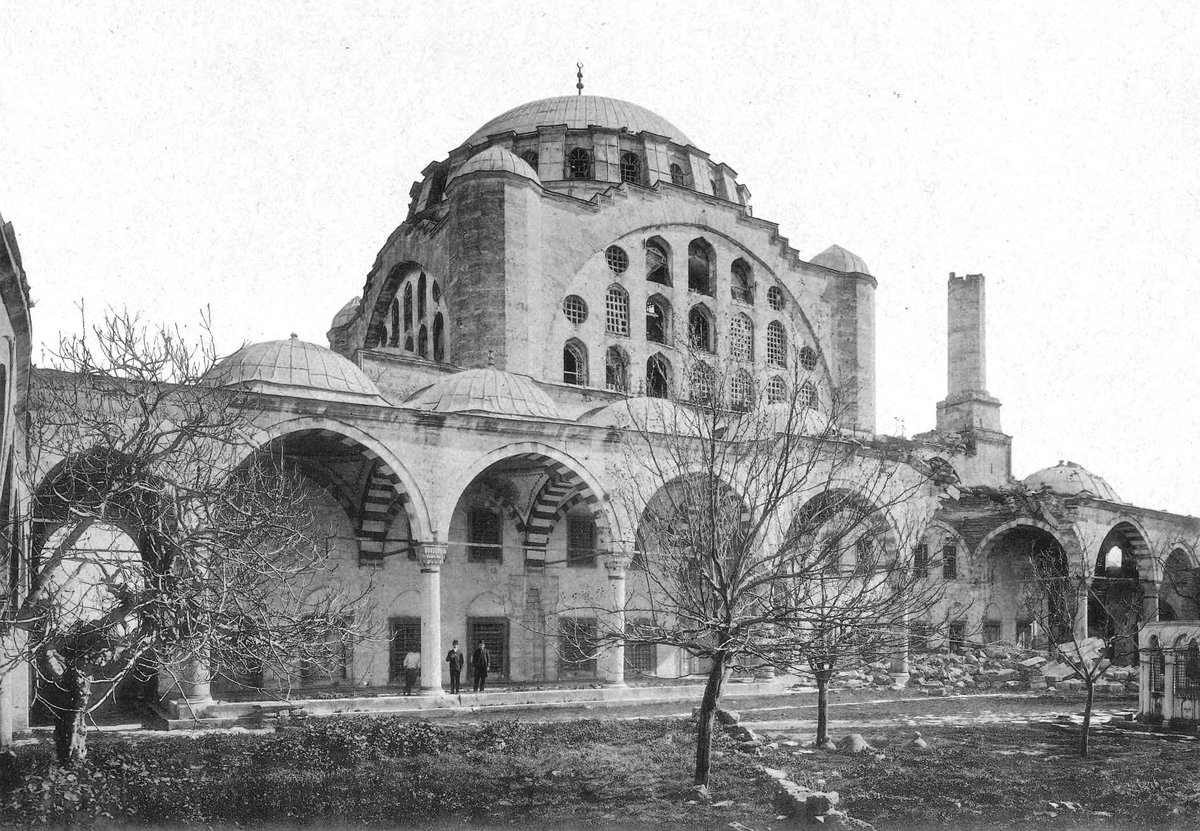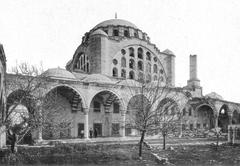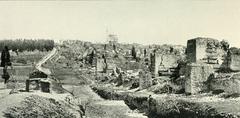
Visiting Mihrimah Edirnekapı Mosque, Istanbul: Comprehensive Guide to Tickets, Hours, History & Tips
Date: 14/06/2025
Introduction
Perched atop one of Istanbul’s highest hills, the Mihrimah Edirnekapı Mosque stands as a luminous monument to the grandeur of Ottoman architecture and the influential legacy of Mihrimah Sultan, daughter of Sultan Suleiman the Magnificent and Hürrem Sultan. Designed by the legendary imperial architect Mimar Sinan and completed between 1563 and 1570, this mosque is a testament to the artistic, cultural, and spiritual achievements of the Ottoman Empire. Its commanding position in the Edirnekapı district offers sweeping views of the city and places it at the crossroads of Byzantine and Ottoman history.
This guide explores the mosque’s rich historical background, architectural innovations, symbolic significance, and provides all the practical information you need to plan a rewarding visit—including opening hours, ticket details, accessibility, and nearby attractions. Whether you are a history enthusiast, architecture lover, or cultural explorer, the Mihrimah Edirnekapı Mosque is an essential stop for discovering Istanbul’s layered heritage.
Table of Contents
- Historical Background & Patronage
- Architectural Highlights & Innovations
- Symbolism and Myths
- The Edirnekapı District & Historical Setting
- Visiting Information: Hours, Tickets & Etiquette
- Accessibility & Facilities
- Guided Tours & Interpretation
- Nearby Attractions
- Frequently Asked Questions (FAQ)
- Practical Tips for Visitors
- Conclusion & Recommendations
- Sources
Historical Background & Patronage
The Mihrimah Edirnekapı Mosque was commissioned by Mihrimah Sultan, the only daughter of Sultan Suleiman the Magnificent and Hürrem Sultan, at the height of the Ottoman Empire’s power (Free Istanbul Guide). Mihrimah Sultan was a prominent patron of architecture, education, and charity, playing a key role in imperial philanthropy and urban development. Entrusted to Mimar Sinan—the most celebrated architect of the era—the mosque was constructed from 1563 to 1570, reflecting the zenith of classical Ottoman architecture (Nomadic Niko; Istanbul Tour Studio).
The site of the mosque, previously occupied by a Byzantine church, was chosen for its strategic and symbolic significance, near the Theodosian Walls and Edirne Gate—the historic entry point for Mehmed the Conqueror in 1453. This location underscores the mosque’s role as a bridge between Istanbul’s Byzantine and Ottoman eras (Nomadic Niko).
Architectural Highlights & Innovations
Külliye Complex
True to Ottoman tradition, the mosque was conceived as a külliye—a multi-functional complex that originally included a madrasa (religious school), hamam (bathhouse), shops, tombs, and a soup kitchen. These elements not only served religious and educational purposes but also provided social services and generated income for the mosque’s upkeep (myforevertravel.com).
Prayer Hall & Dome
The mosque’s prayer hall is among the most luminous in Ottoman architecture, thanks to 204 windows—some adorned with stained glass. The vast central dome, 20 meters in diameter and rising 37 meters above the floor, is supported by slender piers and complemented by semi-domes, creating a sense of spaciousness and harmony (Nomadic Niko). The light-filled interior is a hallmark of Sinan’s genius and contributes to the mosque’s serene atmosphere.
Courtyard & Minaret
A colonnaded portico encloses the courtyard, featuring a central ablution fountain (şadırvan) supported by 16 columns. The single, elegant minaret distinguishes the mosque from other imperial complexes, which often have multiple minarets (Istanbul Tour Studio).
Decorative Elements
Inside, the white marble mihrab and intricately carved minbar are original highlights. Subtle Iznik tiles and calligraphic inscriptions enhance the aesthetic without detracting from the architectural clarity. Many of the decorative elements seen today are the result of careful restorations following earthquake damage over the centuries (Nomadic Niko).
Symbolism and Myths
The name “Mihrimah” means “sun and moon” in Persian, and this celestial symbolism is woven into the mosque’s design and folklore. According to legend, Sinan’s unrequited love for Mihrimah Sultan inspired him to construct two mosques—one in Edirnekapı and another in Üsküdar—so that, during the spring equinox, the setting sun aligns with the Edirnekapı mosque as the moon rises above the Üsküdar mosque, a poetic tribute to her name (Istanbul Tour Studio; worldbestmosques.com). While the historical accuracy of this tale is debated, it adds a layer of romance and mystique to the mosque’s story.
The Edirnekapı District & Historical Setting
Edirnekapı is steeped in both Byzantine and Ottoman history. Its proximity to the ancient Theodosian Walls and the historic Edirne Gate situates the mosque at a significant urban and symbolic crossroads. The area retains a local, authentic atmosphere, with a mix of residential streets, traditional shops, and local eateries (Nomadic Niko). Nearby, visitors can explore the Chora Church (Kariye Mosque), the Edirnekapı Martyrs’ Cemetery, and Mihrimah Sultan Park.
Visiting Information: Hours, Tickets, & Etiquette
- Opening Hours: The mosque is open daily from 9:00 AM to 6:00 PM, except during prayer times when access to the prayer hall is restricted. It is advisable to check prayer schedules and avoid visiting during Friday prayers and religious holidays (Free Istanbul Guide; worldbestmosques.com).
- Entry Fee: Entrance is free; donations for maintenance and restoration are appreciated.
- Dress Code: Modest dress is required. Men should wear long trousers and sleeved shirts; women are expected to cover their hair, arms, and legs. Headscarves are available at the entrance.
- Photography: Allowed in the courtyard and prayer hall, but visitors should avoid flash and be respectful during prayers.
Accessibility & Facilities
- Access: The mosque is easily reachable by public transport—via the T4 tram (Edirnekapı stop), several bus lines, or by taxi. Parking is limited, so public transit is recommended.
- Mobility: Wheelchair access is available at the main entrance. Some areas have uneven floors or steps; staff can assist as needed.
- Facilities: Restrooms and ablution facilities are available near the entrance. Modest souvenirs and religious texts may be sold at a kiosk.
Guided Tours & Interpretation
English-speaking staff and volunteers can often provide historical and architectural insights. For a more in-depth experience, consider joining a city-wide guided tour that includes the mosque. Panels in Turkish and English provide context on Mihrimah Sultan, Mimar Sinan, and the mosque’s features (Istanbul Tourist Pass).
Nearby Attractions
- Chora Church (Kariye Museum/Mosque): Renowned for its Byzantine mosaics and frescoes.
- Edirnekapı Martyrs’ Cemetery: Important for understanding the city’s modern history.
- Mihrimah Sultan Park: Offers panoramic views of the Golden Horn and city skyline.
- Theodosian Walls: A short walk away, these ancient fortifications provide historical context for the area.
Frequently Asked Questions (FAQ)
Q: What are the visiting hours of Mihrimah Edirnekapı Mosque?
A: Open daily from 9:00 AM to 6:00 PM; closed during prayer times and religious holidays.
Q: Is there an entrance fee?
A: No, entrance is free. Donations are welcome.
Q: Are guided tours available?
A: City-wide guided tours often include the mosque; English-speaking staff are available on-site.
Q: Is the mosque wheelchair accessible?
A: The main entrance and courtyard are accessible, though some areas have steps. Staff can assist.
Q: What is the dress code?
A: Modest attire is required for all visitors. Headscarves are provided for women.
Q: Can I take photos inside?
A: Photography is allowed, but be respectful and avoid flash, especially during prayers.
Practical Tips for Visitors
- Plan your visit outside of prayer times for easy access.
- Dress modestly and bring a headscarf if possible.
- Remove shoes before entering the prayer hall; bags are provided.
- Take time to explore the courtyard and enjoy the panoramic views.
- Combine your visit with nearby attractions for a richer experience.
- Be respectful of worshippers and local customs.
Conclusion & Recommendations
The Mihrimah Edirnekapı Mosque seamlessly blends architectural innovation, spiritual symbolism, and Istanbul’s layered history. Its luminous prayer hall, commanding location, and fascinating legends provide a compelling reason to explore beyond the city’s most famous sites. With free admission, welcoming staff, and easy accessibility, the mosque is ideal for travelers seeking both cultural depth and moments of tranquility.
Sources
- Free Istanbul Guide
- Nomadic Niko
- Istanbul Tour Studio
- Wikipedia
- worldbestmosques.com
- istanbul.com
- myforevertravel.com
- istanbul.tips
- turkiyeworld.com
- Istanbul Tourist Pass























































































































